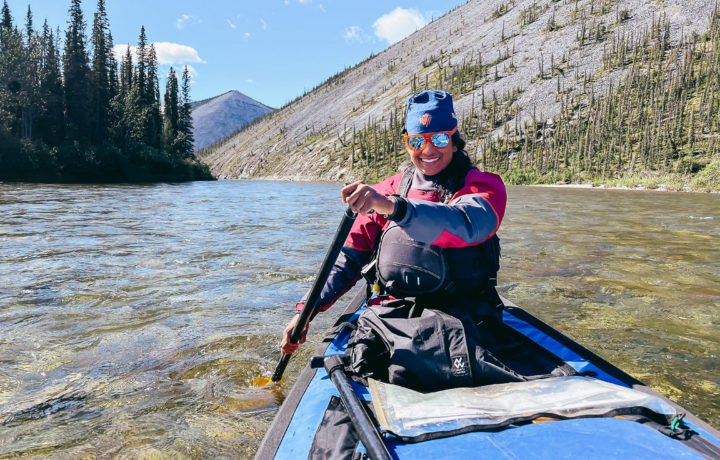One year ago, Niki Choo approached us with a simple but wild idea – a human powered wilderness traverse, connecting the Pacific and Arctic oceans in 3 months…
This is her story:
We were starting two weeks later than we expected, and I worried about finishing the trip before it started to snow in the Arctic. There had been 200% of the snowfall in the Yukon this winter, so high water was another thing on my mind as we started out from Haines AK.
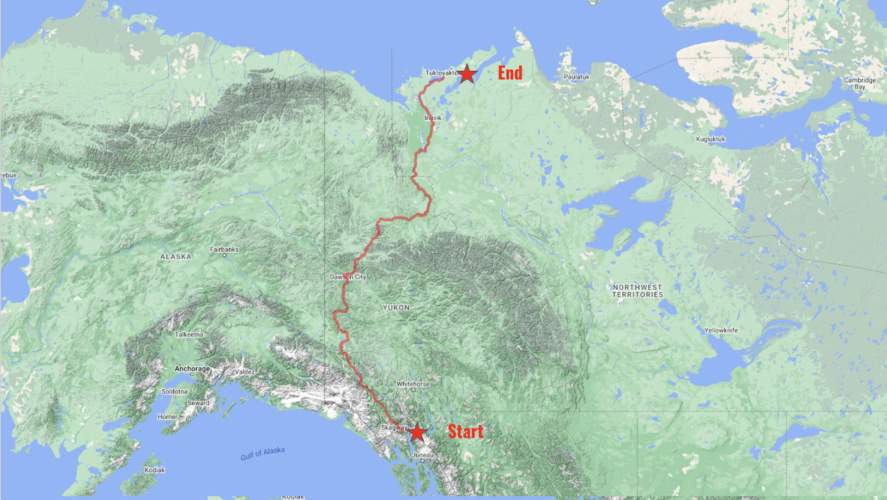
We paddled from Hidden Cove (Haines, AK) into the mouth of the Chilkoot River before jumping on bikes to pedal our way to Kluane Lake. We biked over 162 miles through mountain passes and got to see some spectacular peaks. Three Horsemen, in particular, stood out to me as one of the most impressive. It made me wish we had more time to stop and explore and hike a few days, but this early in the trip we weren’t sure if time was going to be on our side.
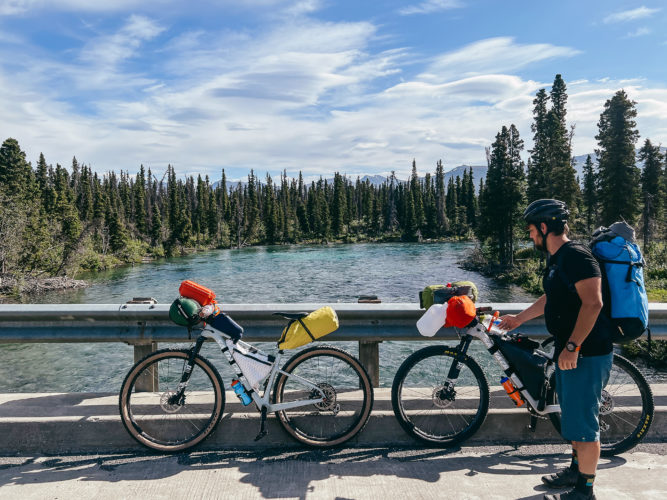
June brought hot weather and long days. The sun didn’t set till about midnight most days so we found ourselves in our winter tent wishing we had some cooler weather. Most days we pedaled anywhere from 6–10 hrs, climbing anywhere from 1000 to 2800 feet in a day. The days were long, but we were happy to be making good progress. While our trip wasn’t really about bike packing, we looked forward to when we could carry more things and be in the canoe.
Most of our meals at this point were backpacker meals; Dottie’s Chicken and Dumplings, Many Beans Salad and Deli-Smoked Roast Beef Wrap were among our favorites. It made me feel really good about what we were eating even when weight and space were precious resources.
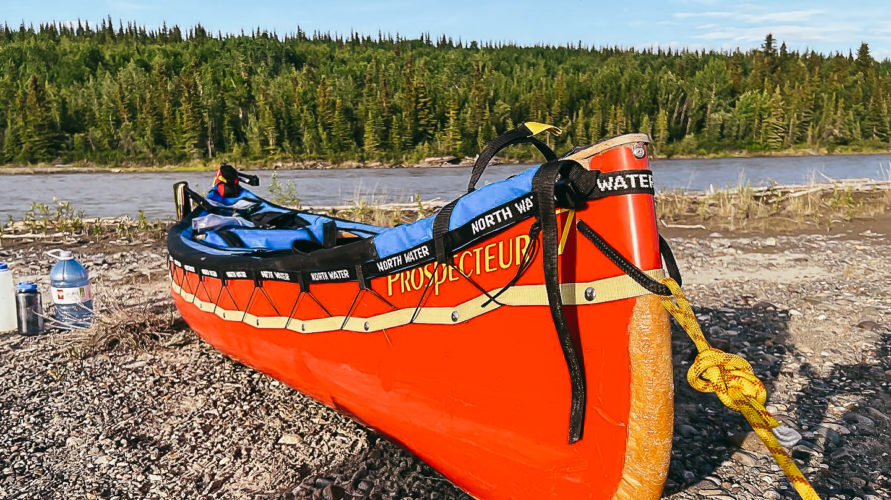
Making it to Kluane on bikes was a milestone in itself. We were just about 10 days on bikes, and our transition point was at the Techàl Dhâl Visitor Center. There, we met our friend Whit, who had our canoe and the rest of our gear. The boat would be our home for the next 2 months! It housed all our food, gear and clothing. At first, it felt weird to only be carrying enough for 3 weeks at a time, but after that first transition dipping our paddles in the water, we slowly built our paddling muscles.
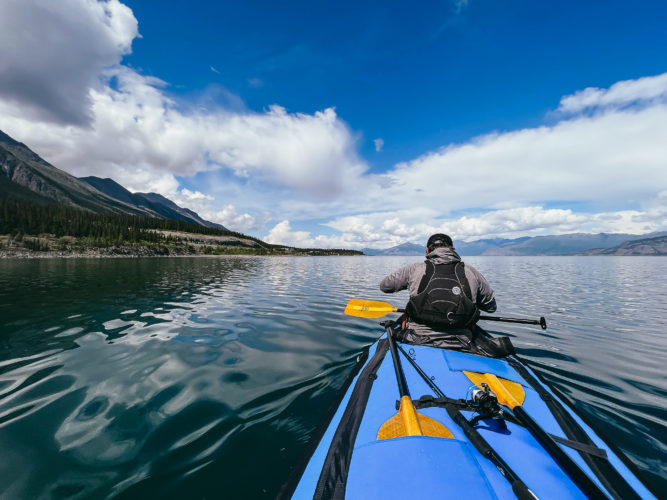
Kluane Lake was flat and glassy as we paddled over 70 miles of flat water to get to the headwaters of the Kluane River. We knew that we would have 2 large rapids in the first 10 miles, so as we began to feel the pull of the current, my heart began beating a little faster wondering where and when we’d hit the first rapids.
When we neared the first, Jared and I got out to scout, we scrambled up a 30 foot embankment so we could get good eyes on it. It was big but not impossible. We gathered speed and hit the line perfectly, water splashing over the bow, and the boat rocking in the wave train. We learned quickly as water started to pour into our skirt that securing those tightly before whitewater would be important.
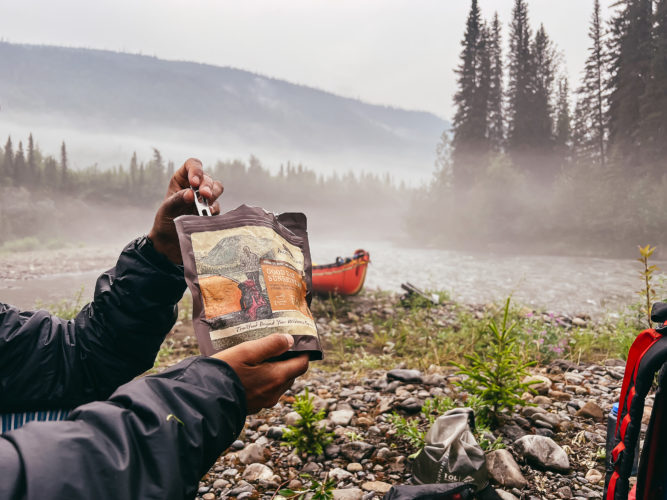
Kluane River, the Donjek and the White were all very fast moving. The silty waters made it hard to see where it was shallow, and we had to dodge many strainers and sweepers. Sometimes we would move at 10 mph and it kept us on our toes. The rivers in some spots were so large it was hard to see across the whole thing. Those days on the Donjek and White were cold and sometimes rainy. It was so nice to be able to cook a good meal.
The times where we ended late (13 hour paddling days) we did quick backpacker meals, and other nights when the weather cooperated we dreamed up meals with our Packit Gourmet bulk food. It was my first time cooking with bulk dried food, and after those first few meals, I don’t think I’ll ever go back. Now, whenever friends consult me about long expedition like trips, I tell them to check out Packit’s selection of bulk food.
What I found was that it was really nice to be creative in this way when you’re on a long trip! You can make the food you’re craving in the way that you want. We often ate ground beef with rice, carrots, celery and tomatoes. To have these nourishing food options on an expedition like this was priceless.
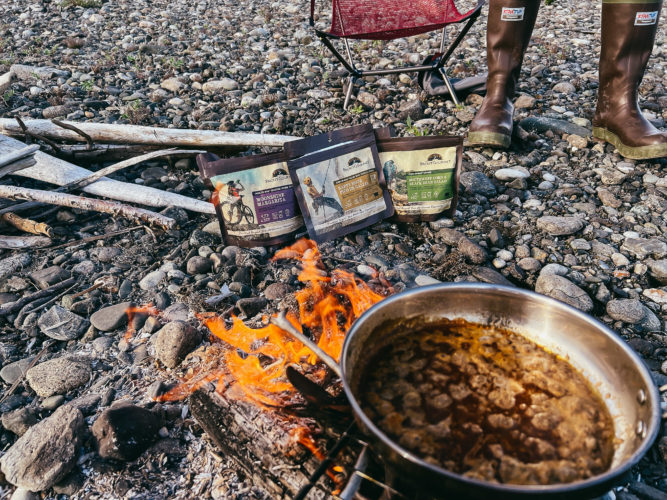
Ramen was a big hit on those cold days, we often added edamame beans, spinach & Spam to those meals. If we had any left over would carry it in a Nalgene for the next day.
Once the White River spit us out onto the Yukon, I felt a sigh of relief. There weren’t any strainers and log jams to contend with, only fast moving water all the way to Dawson. The Yukon was also in flood, so campsites were hard to find. It was one of the only times Jared and I unloaded the boat and hung out in the tent all evening to avoid the swarms of mosquitos that tried to suck our bodies dry.
Dawson City sits on the eastern shore of the Yukon River and that’s where we got our second drop. We wanted to be as light as possible because about 16 miles downstream of Dawson is where we’d turn right and head upstream on the Chandindu. The Chandindu proved to be way more water than we expected, it was pushy and dangerous, and we met over 50 log jams, strainers and hazards as we moved 18 miles upstream. It was a really difficult call to make, but after battling the 9mph current, taking a few close calls, and knowing we’d have to make more difficult moves, we decided the hazards / stress were too much. We turned around and came back down the Chandindu, opting to access Seela Pass and the Continental Divide another way.
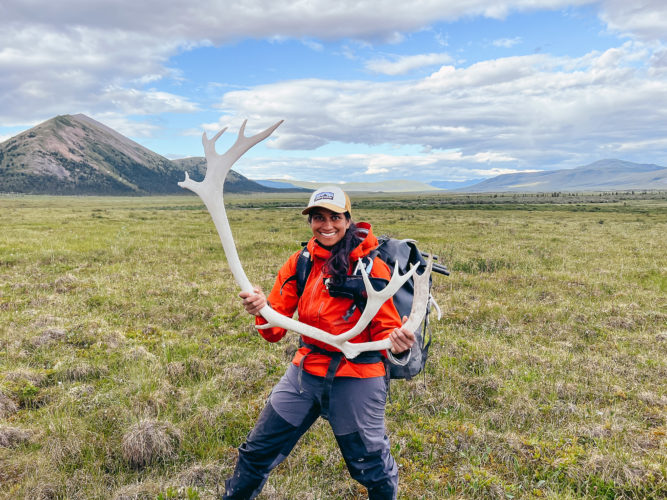
After re-evaluating and recalibrating for upstream, we got into Seela Pass. This is the area where the two watersheds divide. From then on we’d be in the Peel watershed, all of which flows directly into the Arctic. Upstreaming the Blackstone was way more chill than the Chandindu and made us feel redeemed by making good progress and getting into Seela Pass. Seela Pass was spectacular. Not a single sign of other human activity the entire time we were there. We saw moose and bear and heard wolves. There was ice still covering Seela Creek for over a mile, and it amazed me the blue crystal color of the water.
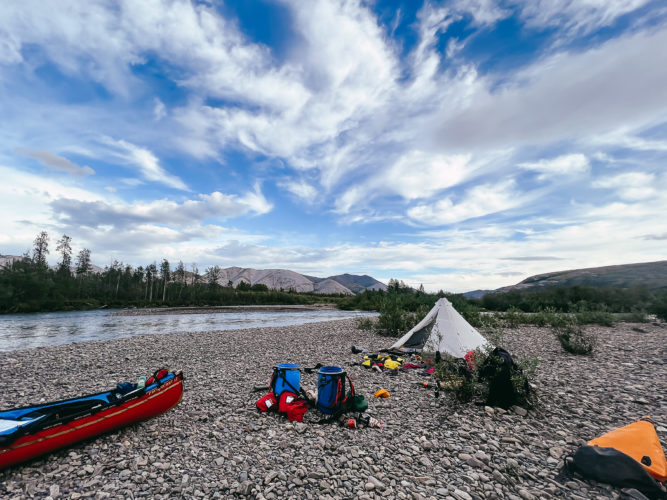
Seela Pass was the highest elevation we’d reach on trip. Everything from that point onwards was downstream, and it felt good to have that milestone behind us.
As we transitioned back to the boat and started to paddle down the Blackstone we relished in the ease of moving with the water, instead of against. The Blackstone is a spectacular river, winding its way through mountains and imposing rock. We did some hiking along the way, but mostly just navigated the class II white water, camped on gravel bars, and watched the crystal clear water flow beneath our boat and off our paddles.
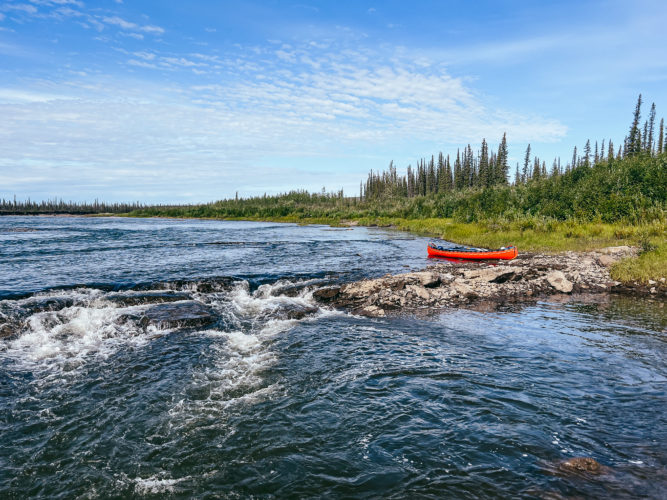
The Blackstone flows into the Peel (a river twice or three times as large as the Blackstone) and we had to be careful not to get caught in the middle of the river when a rapid was coming. There were some big class III rapids that we ran (damaging the boat on one), and some class IV rapids we lined around. On the Peel there is a class V section of whitewater, called Aberdeen Canyon we had to portage around. The portage itself took us 2 days to complete. On day one we did two trips, first with our barrels the second with our dry bags. The second day we went back for the canoe and slogged it up and over trees, mud, muskeg, and tussocks. At the end of the portage we had to line the boat down a steep embankment. Thankfully, after the canoe we were done! One of the hardest parts of the trip was over! From there, a lot of the technical whitewater and river hazards were behind us.

And as we continued to paddle the Peel towards Fort McPherson, the river changed. Wind started to become a factor and for few days, we couldn’t go anywhere because the wind was so fierce. Many more rivers flow into the Peel, so by the time we arrived at McPherson the river was slow moving and silty.
Our final resupply was waiting for us at Fort McPherson. We had the help of the Royal Canadian Mountain Police, and ended up cooking a feast for some of them as a thank you. But before we knew it, we were back on the water and headed into the last leg of the trip.
We were in big water…the Peel flows into the Mackenzie, which was sometimes over 3 miles wide! We had to go upstream on the Mackenzie for a short period to get into the East Channel of the Mackenzie, which would dump us out on the Arctic Ocean. For the most part the weather cooperated, but there was one night (close to the Arctic Ocean) that brought in a gnarly storm. We had to scramble to high ground to avoid getting flooded. We later learned the locals call this spot Hurricane Alley because when the wind blows it’s so stormy you can’t even get up this area in a motor boat. It was scary to be pushed around in the water, and that night we slept in soaked tent in wet sleeping bags and mattresses. Thankfully, we made it out unscathed for the most part.
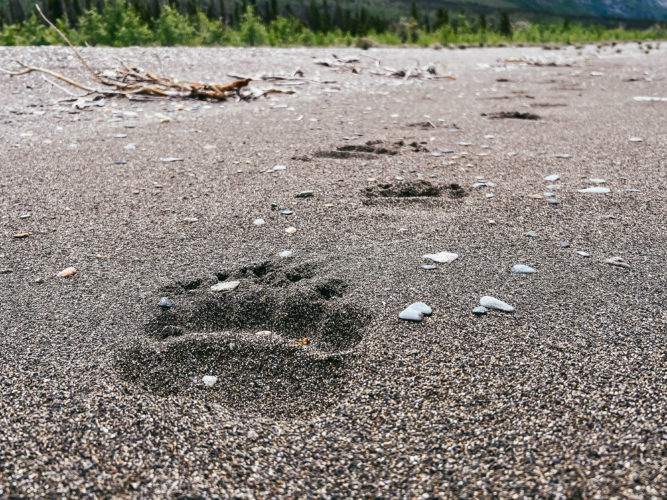
We stayed with some reindeer herders (Inuvialuit First Nations) at a whaling camp where we dried out our gear and caught up on sleep. We were lucky to have a small weather window allowing us to paddle from the whaling camp into Tuk. The sky was immense in front of us, and because the curvature of the earth is less there, things seemed very very big in the distance.
Nearing Tuk felt monumental and, in many ways, unbelievable! We had just traveled from the Pacific to the Arctic in just under 3 months! We met other folks who had come down the Mackenzie but stopped early because they had only packed lentils and rice for food.
I was thankful to have Packit on our side. Never did I feel uninspired by the food we were carrying, and anytime I cooked from bulk food it made my heart sing knowing I was putting healthy and organic food in my body, fueling me for weeks and months.
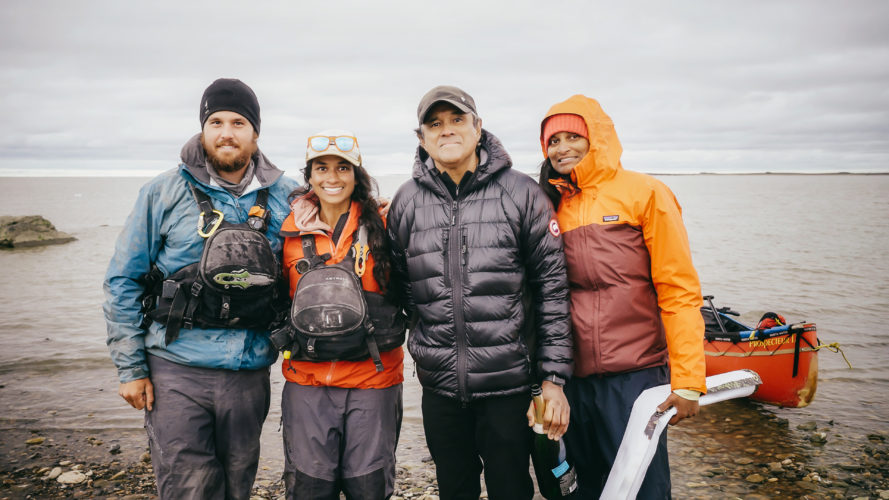
Niki is an ambassador for WeGotNext, an organization working to amplify stories of adventure and activism for communities underrepresented in the outdoor and environmental spaces. No doubt about it, Niki will have more expeditions ahead. To see more photos & videos from this expedition, follow along @nikichoochoo & @wegotnextorg!

